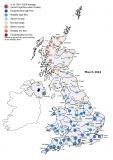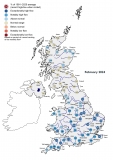Definition
The Annual Maximum (AMAX) series contains the largest observed flow (in cubic metres per second, abbreviated to m3s-1 and sometimes also referred to as 'cumecs') in each water year.
Missing Data
Users may note instances when the AMAX record has no data for a water year, but there is no entry in the missing data table. Incomplete or partial years due to missing data present a difficulty in calculating the annual maximum flow. The AMAX plot shows the highest flow in each water year, but also indicates whether or not this value is likely to be the true annual maximum plot:
- A blue bar indicates that the data for that water year are complete, and the AMAX given in the plot is most likely to be the maximum flow for that year.
- A yellow bar indicates missing data periods within one water year. Therefore, the AMAX given in the plot may not be the maximum flow for that year. These are listed as rejected years in the .am file which is downloaded for WINFAP-FEH. By default, these are excluded from analysis within WINFAP, although the user can choose to include them.
Ideally, where there is missing data within an AMAX series, the values should be compared with a nearby station on the same river. If this is not available, rainfall records and stations on nearby rivers with similar catchment characteristics can be used.
Pre-digital Record
Initially, missing periods in the pre-digital record were identified as those where more than 25% of the time period was missing. The first or last POT in a series were used as an indicator of the possible incompleteness of a water year (e.g. if the first POT in the water year did not occur until February, then the year would be provisionally flagged as incomplete).
This process was applied not only to the first year of record, but also to any gaps in the record - to the first AMAX value, to the AMAX value before a missing year, and to the AMAX value after a missing year. Any missing years were then re-included in analysis if the AMAX for the water year was in the top 37% of the other AMAX values for the station. This 37% was defined based on the likely effect of the criteria:
- Exclusion of values above QMED will reduce the QMED estimate derived from the AMAX series
- Retention of anomalous values just above QMED will tend to lower station growth curves
This 37% threshold was derived from an analysis of the data in all complete years, to include data series which are likely to give reasonable estimates of both QMED and growth curves. We welcome feedback from users on specific values where stations have incomplete years. A List of useful definitions are provided as part of the NRFA Glossary here.



